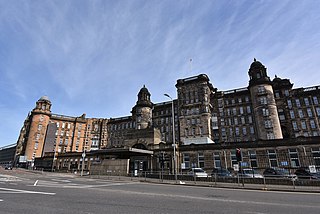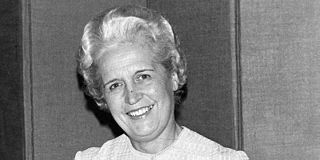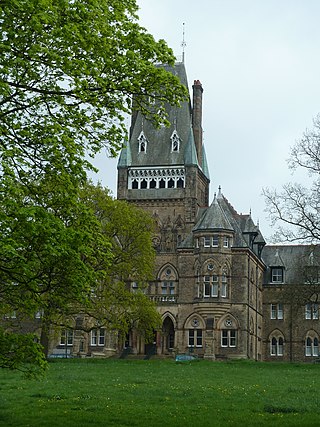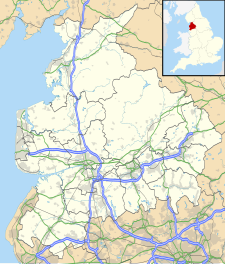
Moorfields Eye Hospital is a specialist National Health Service (NHS) eye hospital in Finsbury in the London Borough of Islington in London, England run by Moorfields Eye Hospital NHS Foundation Trust. Together with the UCL Institute of Ophthalmology, which is adjacent to the hospital, it is the oldest and largest centre for ophthalmic treatment, teaching and research in Europe.

The Royal London Hospital is a large teaching hospital in Whitechapel in the London Borough of Tower Hamlets. It is part of Barts Health NHS Trust. It provides district general hospital services for the City of London and Tower Hamlets and specialist tertiary care services for patients from across London and elsewhere. The current hospital building has 845 beds and 34 wards. It opened in February 2012.

Whittington Hospital is a district general and teaching hospital of UCL Medical School and Middlesex University School of Health and Social Sciences. Located in Upper Holloway, it is managed by Whittington Health NHS Trust, operating as Whittington Health, an integrated care organisation providing hospital and community health services in the north London boroughs of Islington and Haringey. Its Jenner Building, a former smallpox hospital, is a Grade II listed building.

The Glasgow Royal Infirmary (GRI) is a large teaching hospital. With a capacity of around 1,000 beds, the hospital campus covers an area of around 8 hectares, and straddles the Townhead and Dennistoun districts on the north-eastern fringe of the city centre of Glasgow, Scotland. It is managed by NHS Greater Glasgow and Clyde. It was originally opened in 1794, with the present main building dating from 1914.

The Bristol Royal Infirmary, also known as the BRI, is a large teaching hospital in the centre of Bristol, England. It has links with the nearby University of Bristol and the Faculty of Health and Social Care at the University of the West of England, also in Bristol.

North Manchester General Hospital (NMGH) is a large NHS hospital in Crumpsall, North Manchester, England. It is operated by Manchester University NHS Foundation Trust. There is an accident and emergency unit, together with a maternity unit, high dependency unit and a mental health wing. A plan to rebuild the hospital was announced by Boris Johnson in the 2019 General Election campaign, and in November 2020 a £54 million funding bid for improvement works was made by the Trust, Manchester City Council, and Manchester Health and Care Commissioning.

Dame Sheila Margaret Imelda Quinn, DBE, FRCN, RGN, RM, RNT, was a British nurse and fellow of the Royal College of Nursing. She was president of the Royal College of Nursing (RCN) from 1982 to 1986. She was awarded an RCN Fellowship (FRCN) in 1978.

Leicester General Hospital (LGH) is a National Health Service hospital located in the suburb of Evington, about three miles east of Leicester City Centre, and is a part of University Hospitals of Leicester NHS Trust. It has approximately 430 beds. The hospital is the largest employer in the area.
NHS North West was a strategic health authority (SHA) of the National Health Service in England. It operated in the North West region, which is coterminous with the local government office region.

East Lancashire Hospitals NHS Trust is an NHS hospital trust in Lancashire, England. It was established on 1 September 2002, as the result of a locally controversial, cost saving merger of Blackburn Hyndburn & Ribble Valley NHS Trust and Burnley Health Care NHS Trust, first announced in September 1999.

Westmorland General Hospital (WGH) is a hospital near Oxenholme in Kendal, Cumbria, England. It is managed by the University Hospitals of Morecambe Bay NHS Foundation Trust.

The Hospital of St. Cross is a National Health Service hospital on Barby Road, in Rugby, Warwickshire, England, managed by the University Hospitals Coventry and Warwickshire NHS Trust. It is on the south edge of Rugby above a steep slope running down to the Sow Brook valley.

Cumberland Infirmary is a hospital in Carlisle, Cumbria, England. It is managed by the North Cumbria Integrated Care NHS Foundation Trust.

Edward Denis de Vitre was an English physician, twice mayor of Lancaster, England, and one of the founders of the Royal Albert Hospital in Lancaster.
University Hospitals of Morecambe Bay NHS Foundation Trust is an NHS Foundation Trust in North West England, providing services in South Cumbria and North Lancashire in the Morecambe Bay area. It has about 6,000 employees and provides services for some 350,000 people.
Lancaster Medical School (LMS) is located in Lancaster, Lancashire in North West England and is part of the Faculty of Health and Medicine at Lancaster University. It is currently the UK's newest public medical school, with its first graduates, a cohort of 31, graduating in 2011. The current head of the medical school is Professor Marina Anderson.
Wrightington, Wigan and Leigh Teaching Hospitals (WWL) NHS Foundation Trust is an NHS Foundation Trust providing services in the Metropolitan Borough of Wigan and Wrightington, England. It was formed on 1 April 2001 by the merger of Wrightington Hospital NHS Trust and Wigan and Leigh Health Services NHS Trust, and became an NHS Foundation Trust in December 2008. "Teaching Hospitals" has been included in its name since 1 April 2020.
Healthcare in Cumbria was the responsibility of Cumbria Clinical Commissioning Group until July 2022. On 1 April 2017 32 GP practices left the CCG and merged with Lancashire North CCG to form Morecambe Bay CCG.
Healthcare in Lancashire in 2015 was the responsibility of seven clinical commissioning groups covering Blackpool, Chorley and South Ribble, East Lancashire, Fylde and Wyre, Greater Preston, Lancaster North and West Lancashire. In 1 April 2017 32 GP practices from Cumbria Clinical Commissioning Group merged with Lancashire North CCG to form Morecambe Bay CCG which was abolished in July 2022 when integrated care systems were introduced.

Highgate Hospital was a name used to refer to the infirmary building which opened in 1869 on the St Pancras side of Dartmouth Park Hill in Highgate, London.















